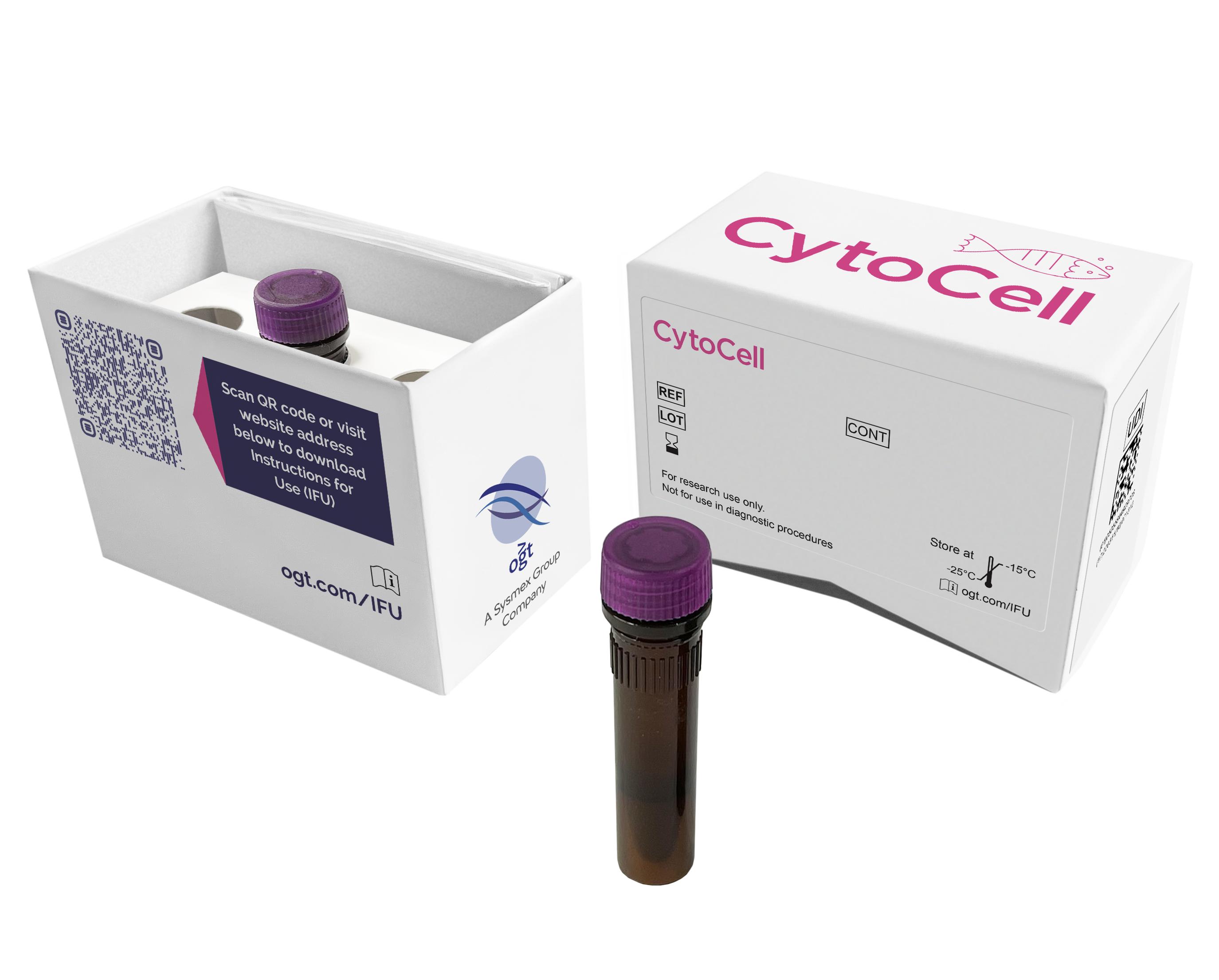
The Prader-Willi/Angelman (SNRPN) probe is 170kb, labelled in red and covers the whole SNRPN gene as well as entire imprinting centre. The 15qter subtelomere specific probe (clone 154P1), labelled in green, allows identification of chromosome 15 and acts as a control probe.
Prader-Willi Syndrome (PWS) and Angelman Syndrome (AS) are distinct neurogenetic disorders caused by the loss of function of genes on chromosome 15 (bands 15q11-13), on either the paternally or maternally inherited chromosome, respectively1.
In 70% of patients, a large interstitial deletion of 3-4Mb is observed1,2. In around 3% of patients, an imprinting defect is observed, caused by either an epimutation or a microdeletion of the Imprinting Centre (IC)1,3. Uniparental disomy, in which both chromosome 15s are inherited from the same parent, accounts for most of the remaining patients with PWS/AS1.
The SNRPN gene is one of four imprinted loci that are expressed from the paternal chromosome 15 region (15q11-13) and maps to the minimally deleted region (MDR) involved in PWS5. Its chromosomal location and imprinting status suggest it plays a possible role in the aetiology of PWS4.
The imprinting centre (IC) maps to a 100kb region proximal to SNRPN. Parental deletions or mutations in the IC impair the imprinting process in 15q11-13 and cause one of two distinct diseases in their offspring5,6. Most of the PWS imprinting deletions involve SNRPN and are approximately 200kb in size. The AS imprinting deletions are small (approximately 40kb), involve the BD3 region, and do not include SNRPN.
In vitro diagnostic (IVD)
→ English/Français/Italiano/Deutsch/Español
→ Polski
Research use only (RUO)
Find certificate of analysis documentation for our CytoCell FISH probes
Our lab has been using a wide range of CytoCell FISH probes for a number of years, and have been increasing this range all the time. The probes have clear bright signals and show good reproducibility. CytoCell provides fast delivery of catalogue probes, and are very responsive when we have any queries or problems with their products.

Bridget Manasse
Addenbrookes Hospital, Cambridge University Hosiptals NHS Foundation Trust, UK
In our hands, CytoCell FISH probes have proven to be of the highest quality with bright, easy to interpret signals, thus providing confidence in our results. OGT's customer support is outstanding, as their staff are extremely knowledgeable and truly care about their customers and their customers’ needs.

Jennie Thurston
Director of Cytogenetics, Carolinas Pathology Group, USA
I first came across CytoCell FISH probes in a previous lab I worked in and I was struck by the quality of the products. Since this time, I have been recommending and introducing CytoCell probes across all application areas — now they are the primary FISH probes used in our lab. They have an excellent range of products and their ready-to-use reagent format saves considerable time.

Elizabeth Benner
Medical Technologist, University of Arizona Health Network, USA
We have been working with CytoCell fish probes for two decades because of their excellent clarity and intensity regardless of the size of the probe. It is so clear and simple to detect.
Dr. Marina Djurisic
Head of Laboratory of Medical Genetics, Mother and Child Health Care Institute of Serbia “Dr Vukan Cupic”, Serbia
The quality and consistency of CytoCell’s probes means I can trust the results, and my clients get their results in a timely manner.

Dr. Theresa C. Brown
Director, Cytogenetics Laboratory, Hayward Genetics Center, Tulane University School of Medicine, USA
It was very important for us to have more consistent results with our probes — easy-to-read bright signals and a range of vial sizes, which is much more cost-effective.

Janet Cowan, PhD
Director of the Cytogenetics Laboratory, Tufts Medical Center, USA
Not only do CytoCell offer an extensive range of high-quality FISH probes, the customer support is also excellent — providing fast access to all the probes I need. The probes are highly consistent with bright signals allowing easy scoring of results.
Dr. Eric Crawford
Senior Director, Genetics Associates Inc., USA
The quality and reproducibility of results using the CytoCell kit has been vital in accurately detecting co-deletions in our glioma investigations. We now have a cost-effective test that we can rely on that is also easy to use and interpret. We've been consistently impressed with this kit - not to mention the support offered by OGT's customer service, and have completely transitioned over to CytoCell probes.
Gavin Cuthbert, FRCPath
Head of Cancer Cytogenetics, Northern Genetics Servce, Newcastle, UK